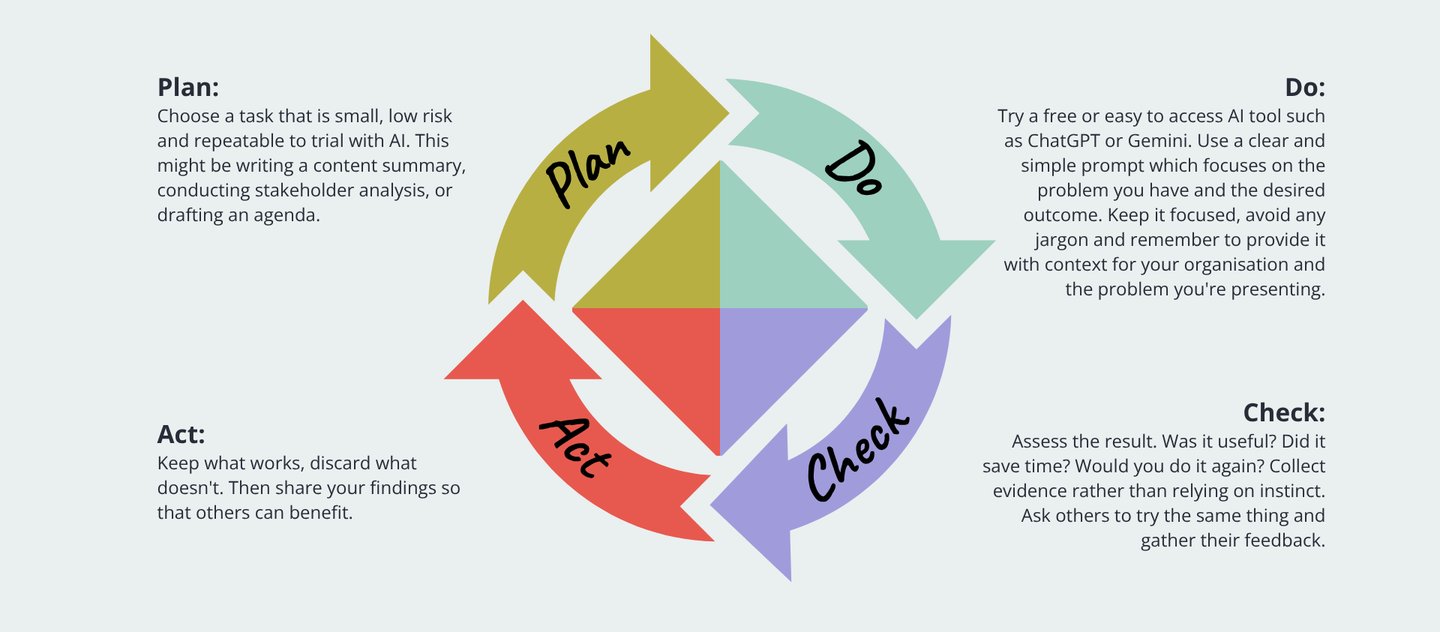Doing More With Less: A Beginners Guide to Adopting AI for Continuous Improvement

If you are reading this you are probably already engaging with AI in some form but are you using it to help solve what is fast becoming the charity sector's most pressing problem; finding ways to do more with less?
I'm not ashamed to tell you that I've used ChatGPT to help shape the structure and flow of this article, test a few different ideas and themes, and ultimately help me with the drafting process whilst our Marketing Manager focuses on relaunching our website. If using AI isn't saving me or someone else in our organisation time, effort or energy then what is the value of it? Using AI shouldn't be about trying to replace or replicate what you're already good at, but it should be about creating efficiencies and new ways of working to allow each of your specialists more time doing the things that have the biggest impact, and that make the most difference to your stakeholders and beneficiaries.
Continuous improvement can seem like a lofty goal when you're struggling to get through the day job, but don't let that put you off, it doesn't have to be complicated, it just needs to start with a problem you think is worth solving. As the proverb says "Necessity is the mother of innovation" - so take something that needs improving, and start using AI to figure out a solution.
First things first; overcome the "budget barrier"
You do not need a big budget to explore AI. Free and affordable tools are widely available.
Here are some options to get started with;
- ChatGPT (Free version available)
Use it to draft content, summarise documents, rewrite communications, or generate ideas. Helpful for funding bids, supporter emails, and strategic planning. - Canva for Nonprofits (Free for eligible charities)
Includes AI-powered writing tools, image generation, and content suggestions. Useful for creating campaign materials, social graphics, and templates. - Grammarly (Free version available)
Supports improved tone, structure, and clarity in written communication. A valuable tool for newsletters, reports, and outreach. - Notion (Free for nonprofits on request)
Offers an AI assistant that can help summarise notes, generate lists, draft plans, or outline briefs. A great tool for collaborative teams managing knowledge and internal documentation. - Microsoft 365 for Nonprofits (Free for eligible charities - up to 10 users)
Includes access to Word, Excel, and Outlook with built-in AI capabilities through Microsoft Copilot. Useful for summarising content, drafting messages, and working more efficiently with documents
Even if an AI tool doesn’t list nonprofit pricing publicly, always ask. Many vendors are willing to offer free trials, scaled pricing, or added support for charities. A conversation can go a long way, especially on a tight budget!
Next; stick to tried and tested frameworks.
If you're familiar with change management you might already be familiar with the PDCA cycle, but it works just as well for adopting AI for continuous improvement as it does for any change management project.
Plan. Do. Check. Act.

This approach doesn't require a big programme of work, or stakeholder buy-in. Trial it with a small group of colleagues on one specific problem, with a small and short feedback loop, then iterate.
Finally; create the conditions and embody the culture of experimentation with AI
AI will only deliver value if those using it aren't afraid to get things wrong and learn from the mistakes along the way. This is not about creating a new policy or strict rules for how AI should be used that ultimately stifle creativity, it is about creating the conditions for curiosity and trust by leading by example.
- Make room for small experiments. Allow people time to try a new tool, even if it takes them longer in the first instance. Circulate a "prompt of the week" in your next team update or newsletter. Ask for an "AI retrospective" each week - where colleagues can reflect on what went well and what didn't and what's been learned going forward. These small efforts build confidence and create a safe space to discuss both the benefits and challenges of using AI as part of the day job.
- Share what works and what does not. A shared document or regular chat thread is enough. Tell others which tools you've tried or failed to use regularly. If someone saves time or discovers a great application for AI in their role, that information can help others gain confidence in experimenting and avoid going over the same ground.
- Use your existing guidance. Most organisation already have good practices for safeguarding, data protection, and external communication. You do not need to re-write the rules to get started with AI, just encourage people to work within the frameworks that already exist, and if they're not sure how they apply, create space for them to ask.
- Be transparent about where and when you're using AI. Using an AI isn't a shortcut to a finished product. Double check everything that is being produced by the AI, in the same way you would usually peer review or conduct quality control and don’t try to pass off work created in collaboration with an AI as anything other than what it is
- Trust your instincts. Especially when it comes to anything that will be shared with your external audiences. If something feels unclear, talk to your peers and get their opinion before sharing more widely. The people who know your organisation from the inside out will be the first to call out anything that doesn't feel right, so don't shy away from feedback and critical reviews. That is how useful and appropriate use of AI will become the new normal.
In conclusion: Start small, stay curious, and continue improving
Embracing AI for continuous improvement doesn’t require a major transformation, it simply needs intention, curiosity, and a willingness to learn. Start with one task, one tool, and one insight. Share what you find, adapt as you go, and build on what works. The real power of AI lies not in replacing your expertise, but in freeing up time and energy so you can focus on the work that matters most. Progress happens through small, deliberate steps and by checking, learning, and adapting along the way.
By following the simple steps in this article, you'll be setting your organisation up for smarter, more sustainable ways of working.



